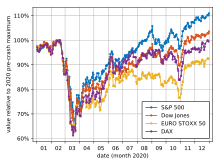Profit (accounting): Difference between revisions
m Replace hyphen with en-dash. |
internal link specific for profit in accounting |
||
| Line 21: | Line 21: | ||
* [[Rate of profit]] |
* [[Rate of profit]] |
||
* [[Profit model]] |
* [[Profit model]] |
||
* [[ |
* [[Income statement]] |
||
==Footnotes== |
==Footnotes== |
||
Latest revision as of 23:48, 6 December 2024
This article includes a list of references, related reading, or external links, but its sources remain unclear because it lacks inline citations. (May 2020) |

Profit, in accounting, is an income distributed to the owner in a profitable market production process (business). Profit is a measure of profitability which is the owner's major interest in the income-formation process of market production. There are several profit measures in common use.
Income formation in market production is always a balance between income generation and income distribution. The income generated is always distributed to the stakeholders of production as economic value within the review period. The profit is the share of income formation the owner is able to keep to themselves in the income distribution process. Profit is one of the major sources of economic well-being because it means incomes and opportunities to develop production. The words "income", "profit" and "earnings" are synonyms in this context.
Other terms
[edit]- Net sales = gross sales – (customer discounts, returns, and allowances)
- Gross profit = net sales – cost of goods sold
- Operating profit = gross profit – total operating expenses
- Net profit = operating profit – taxes – interest
- Net profit = net sales – cost of goods sold – operating expense – taxes – interest
See also
[edit]- Gross income
- Net profit
- Profitability index
- Rate of return
- Return on assets
- Return on equity
- Rate of profit
- Profit model
- Income statement
Footnotes
[edit]References
[edit]- Courbois, R.; Temple, P. (1975). La methode des "Comptes de surplus" et ses applications macroeconomiques. 160 des Collect,INSEE,Serie C (35). p. 100.
- Craig, C.; Harris, R. (1973). "Total Productivity Measurement at the Firm Level". Sloan Management Review (Spring 1973): 13–28.
- Genesca, G.E.; Grifell, T. E. (1992). "Profits and Total Factor Productivity: A Comparative Analysis". Omega. The International Journal of Management Science. 20 (5/6): 553–568. doi:10.1016/0305-0483(92)90002-O.
- Gollop, F.M. (1979). "Accounting for Intermediate Input: The Link Between Sectoral and Aggregate Measures of Productivity Growth". Measurement and Interpretation of Productivity. National Academy of Sciences.
- Hulten, C. R. (January 2000). "Total Factor Productivity: A Short Biography". NBER Working Paper No. 7471. doi:10.3386/w7471.
- Hulten, C. R. (September 2009). "Growth Accounting". NBER Working Paper No. 15341. doi:10.3386/w15341.
- Jorgenson, D.W.; Ho, M.S.; Samuels, J.D. (2014). Long-term Estimates of U.S. Productivity and Growth (PDF). Tokyo: Third World KLEMS Conference.
- Kurosawa, K (1975). "An aggregate index for the analysis of productivity". Omega. 3 (2): 157–168. doi:10.1016/0305-0483(75)90115-2.
- Loggerenberg van, B.; Cucchiaro, S. (1982). "Productivity Measurement and the Bottom Line". National Productivity Review. 1 (1): 87–99. doi:10.1002/npr.4040010111.
- Pineda, A. (1990). A Multiple Case Study Research to Determine and respond to Management Information Need Using Total-Factor Productivity Measurement (TFPM). Virginia Polytechnic Institute and State University.
- Riistama, K.; Jyrkkiö E. (1971). Operatiivinen laskentatoimi (Operative accounting). Weilin + Göös. p. 335.
- Saari, S. (2006a). Productivity. Theory and Measurement in Business. Productivity Handbook (In Finnish). MIDO OY. p. 272.
- Saari, S. (2011). Production and Productivity as Sources of Well-being. MIDO OY. p. 25.
- Saari, S. (2006). Productivity. Theory and Measurement in Business (PDF). Espoo, Finland: European Productivity Conference.
Further reading and external links
[edit]- Fuleky, P. (September 2006). "Anatomy of a Cobb-Douglas Type Production/Utility Function in Three Dimensions". University of Washington.
- Fuleky, P. (October 2006). "Anatomy of a Constant Elasticity of Substitution Type Production/Utility Function in Three Dimensions". University of Washington.
- Moroney, J. R. (1967) Cobb-Douglass production functions and returns to scale in US manufacturing industry, Western Economic Journal, vol 6, no 1, December 1967, pp 39–51.
- Pearl, D. and Enos, J. (1975) Engineering production functions and technological progress, The Journal of Industrial Economics, vol 24, September 1975, pp 55–72.
- Robinson, J. (1953) The production function and the theory of capital, Review of Economic Studies, vol XXI, 1953, pp. 81–106
- Anwar Shaikh, "Laws of Production and Laws of Algebra: The Humbug Production Function", in The Review of Economics and Statistics, Volume 56(1), February 1974, p. 115–120.
- Anwar Shaikh, "Laws of Production and Laws of Algebra—Humbug II", in Growth, Profits and Property ed. by Edward J. Nell. Cambridge, Cambridge University Press, 1980.
- Shaikh, Anwar (Summer 2005). "Nonlinear Dynamics and Pseudo-Production Functions" (PDF). Eastern Economic Journal. 31 (3) – via Holy Cross.
- Shephard, R (1970) Theory of cost and production functions, Princeton University Press, Princeton NJ.
- Thompson, A. (1981) Economics of the firm, Theory and practice, 3rd edition, Prentice Hall, Englewood Cliffs. ISBN 0-13-231423-1
- Elmer G. Wiens: Production Functions - Models of the Cobb-Douglas, C.E.S., Trans-Log, and Diewert Production Functions.
- Profit and Loss, Ludwig von Mises (1951)
- Measuring the Long-Run Profitability of the Firm, Salmi and Virtanen (1997)
